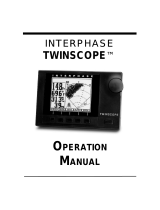Installation:
CAUTION: Disconnect the battery during
installation. Tighten nuts on the
backclamp only slightly more than you
can tighten with your fingers. Six inch-
pounds of torque are sufficient. Over-
tightening could result in damage to the
instrument and may void your warranty.
1. Cut a 3-3/8” diameter hole in the dash
and mount the gauge with the backclamp
supplied.
Follow the enclosed Airmar Technology
Corporation instructions for installing the
multifunction Triducer. Once the Triducer
is installed and you have lead the cables to
the Pilot, connect the wires from the
Triducer to the corresponding 4 or 6-pin
connectors as illustrated using the butt
connectors supplied. The butt connectors
have a heat activated waterproofing. Once
the butt connections have been crimped
slowly apply heat with a heat gun until
you see sealant coming out of the
connector ends. It is recommended to
wrap the connections together with
electrical tape for further protection.
4 - Pin Connector
2. Follow the wiring diagram at the end of
this manual for wiring connections. For
connections for a Yamaha motor use the
connections on HN0362.
For all other engine configurations use the
Others connections on HN0365.
Find both drawings in the back of this
manual.
6 - Pin Connector
3. Follow the wiring diagram at the end of
this manual for wiring connections. For
connections for a Yamaha motor use the
connections on HN0362.
For all other engine configurations use the
Others connections on HN0365.
NOTE: If the transducer cables are not
connected properly or not plugged into the
Pilot, the display will blink when the
power is applied to the unit.
Find both drawings in the back of this
manual.
Page 2
Used for all splices.
Wires
Heat Shrink Tube
(red or blue)
Metal Butt Connector
(red or blue).
Used for all splices.
6-Pin Female
Connector
4-Pin Female
Connector
6-Pin Male Connector
4-Pin Male
Connector
Note: For wiring
diagram for the
4 - Pin connector see
Yamaha (HN0362)
Others (HN0365)
Note: For wiring
diagram for the
6 - Pin connector see
Yamaha (HN0362)
Others (HN0365)
























